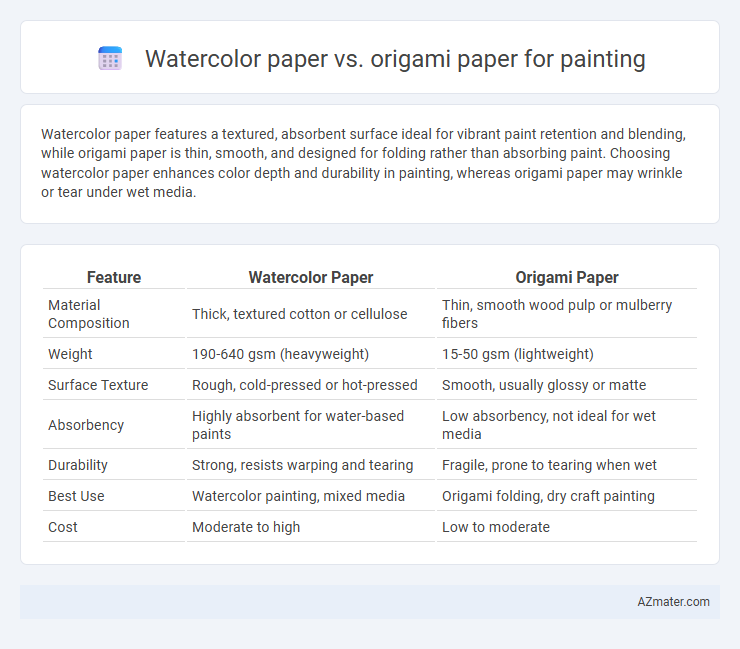Watercolor paper features a textured, absorbent surface ideal for vibrant paint retention and blending, while origami paper is thin, smooth, and designed for folding rather than absorbing paint. Choosing watercolor paper enhances color depth and durability in painting, whereas origami paper may wrinkle or tear under wet media.
Table of Comparison
| Feature | Watercolor Paper | Origami Paper |
|---|---|---|
| Material Composition | Thick, textured cotton or cellulose | Thin, smooth wood pulp or mulberry fibers |
| Weight | 190-640 gsm (heavyweight) | 15-50 gsm (lightweight) |
| Surface Texture | Rough, cold-pressed or hot-pressed | Smooth, usually glossy or matte |
| Absorbency | Highly absorbent for water-based paints | Low absorbency, not ideal for wet media |
| Durability | Strong, resists warping and tearing | Fragile, prone to tearing when wet |
| Best Use | Watercolor painting, mixed media | Origami folding, dry craft painting |
| Cost | Moderate to high | Low to moderate |
Understanding Watercolor Paper and Origami Paper
Watercolor paper is specifically designed to absorb water and pigment, featuring a textured surface and heavier weight that prevents warping during painting. Origami paper, often thin and smooth with vibrant colors, lacks the absorbency needed for watercolor techniques and is primarily suited for folding rather than painting. Understanding the distinct fiber composition and thickness of each paper type is crucial for artists to achieve the desired effect in watercolor artwork versus origami crafts.
Key Differences in Paper Composition
Watercolor paper is typically made from 100% cotton or cellulose fibers, offering high absorption and durability to withstand multiple washes and heavy pigment application. Origami paper is thinner, usually composed of wood pulp or rice fibers, designed for folding rather than absorbing wet media, and lacks the texture necessary for watercolor paint adherence. The key difference lies in watercolor paper's textured surface and thickness, which supports water retention and pigment layering, whereas origami paper is smooth and lightweight, optimized for precision folds rather than paint absorption.
Texture and Surface Quality Comparison
Watercolor paper features a textured, absorbent surface designed to hold and distribute water-based pigments evenly, preventing excessive pooling and allowing for rich color blending. Origami paper, typically smooth and less porous, lacks the absorbency needed for watercolor techniques, often causing colors to sit on top and potentially warp the paper. The rougher texture and higher gsm weight of watercolor paper make it ideal for painting, providing better control over brush strokes and pigment saturation compared to the thin, smooth surface of origami paper.
Absorbency: How Each Paper Handles Paint
Watercolor paper features high absorbency due to its thick, textured fibers, allowing it to hold multiple layers of paint without warping or tearing, making it ideal for water-based techniques. Origami paper, designed primarily for folding, has low absorbency and a smooth surface, causing paint to sit on top and potentially crack or flake when folded. Understanding these absorbency properties helps artists choose the appropriate paper for durability and desired paint effects in their work.
Durability and Resistance to Warping
Watercolor paper offers superior durability and resistance to warping due to its thicker, textured composition designed to absorb water and pigment effectively. Origami paper, typically thin and smooth, lacks the structural integrity to withstand heavy paint application, resulting in easier warping and tearing. Artists seeking longevity and stability in painted works should prioritize watercolor paper for its resilience under wet media.
Color Vibrancy and Pigment Retention
Watercolor paper is specifically designed with high absorbency and a textured surface, enhancing color vibrancy and ensuring superior pigment retention during painting. Origami paper, while often brightly colored and smooth, lacks the absorbent qualities needed for watercolor pigments to settle evenly, resulting in diminished vibrancy and potential pigment bleed. For artists seeking rich, lasting hues and sharp pigment definition, watercolor paper offers a significantly better medium than origami paper.
Suitability for Mixed Media Techniques
Watercolor paper features a textured surface and high absorbency, making it ideal for mixed media techniques that involve wet media like inks and watercolors combined with dry media such as pencils or pastels. Origami paper, typically thinner and less absorbent, is less suitable for heavy applications or layering of multiple media, often warping or tearing when used with wet paints. For artists seeking durability and versatility in mixed media projects, watercolor paper provides a more reliable and professional-quality surface.
Availability, Sizes, and Price Points
Watercolor paper is widely available in art supply stores and online, offered in various sizes such as 9x12 inches, 11x15 inches, and large sheets like 22x30 inches, making it suitable for different painting scales. Origami paper, though commonly found in craft stores and affordable online, is typically sold in smaller sizes like 6x6 inches or 8x8 inches, limiting its usability for traditional painting projects. Watercolor paper generally commands higher price points due to its specialized texture and weight, while origami paper remains cost-effective but lacks the absorbency and durability needed for watercolor techniques.
Artist Recommendations and Use Cases
Watercolor paper is highly recommended by artists for painting due to its thick, textured surface that absorbs water and pigment effectively, preventing warping and allowing for vibrant, detailed artwork. Origami paper, while smooth and lightweight, lacks the durability and absorbency needed for watercolor techniques, making it more suitable for folding and decorative craft projects rather than painting. Artists often prefer watercolor paper for techniques requiring layering and blending, while origami paper is chosen for precise folds and color patterns in paper art.
Final Verdict: Which Paper is Best for Painting
Watercolor paper is best suited for painting due to its high absorbency, textured surface, and durability, allowing for vibrant colors and smooth blending. Origami paper, while lightweight and easy to fold, lacks the thickness and water resistance needed for most painting techniques, often resulting in warping or tearing. For artists prioritizing color quality and paper stability, watercolor paper offers superior performance and longevity.

Infographic: Watercolor paper vs Origami paper for Painting
 azmater.com
azmater.com